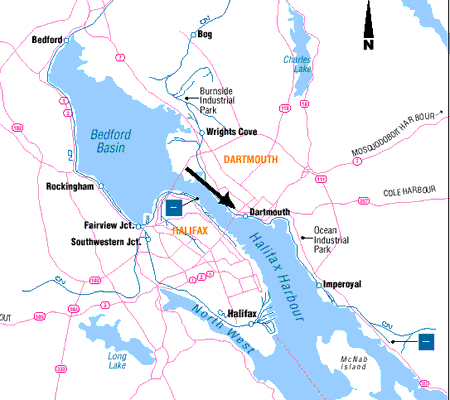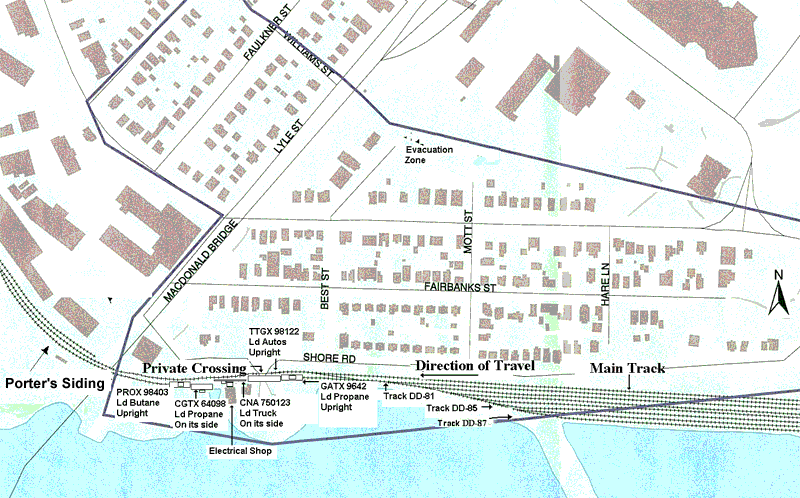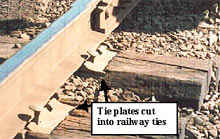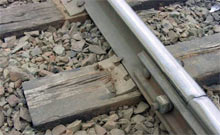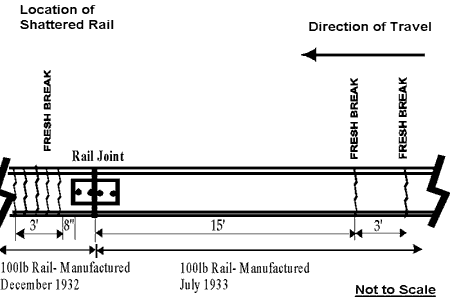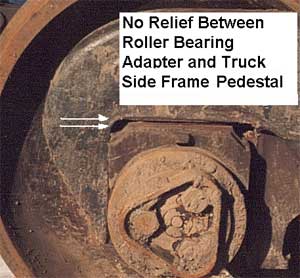Yard Derailment
Canadian National
0700 Yard Assignment
Mile 12.15, Dartmouth Subdivision
Dartmouth, Nova Scotia
The Transportation Safety Board of Canada (TSB) investigated this occurrence for the purpose of advancing transportation safety. It is not the function of the Board to assign fault or determine civil or criminal liability. This report is not created for use in the context of legal, disciplinary or other proceedings. See Ownership and use of content. Masculine pronouns and position titles may be used to signify all genders to comply with the Canadian Transportation Accident Investigation and Safety Board Act (S.C. 1989, c. 3).
Summary
On 15 February 2002, at approximately 0955 Atlantic standard time, Canadian National 0700 yard assignment, while switching cars in Dartmouth, Nova Scotia, derailed five cars on the west end of the yard in track DD-68, commonly referred to as Porter's Siding, blocking a private crossing to an electrical shop. Three of the derailed cars were tank cars loaded with liquefied petroleum gas, Class 2.1, UN 1075, and the other two cars were flat cars loaded with vehicles. There was no leak nor any injury; however, as a precautionary measure, approximately 800 Dartmouth residents were evacuated from their homes, and the Angus L. MacDonald suspension bridge, one of the two major bridges connecting Dartmouth and Halifax, was closed for 12 hours during the recovery effort.
Ce rapport est également disponible en français.
1.0 Factual information
1.1 The accident
On 15 February 2002, at approximately 0955 Atlantic standard timeFootnote 1, Canadian National (CN) 0700 yard assignment was coming to a controlled stop after pulling 15 cars in a westward direction when a train-initiated emergency brake application occurred. A subsequent inspection by the three crew members revealed that tank car PROX 98403 (a load of butane that was coupled to the locomotive) was derailed but upright; the following tank car, CGTX 64098 (a load of propane) was on its side toward the harbour edge; flat car CNA 750123 (loaded with a truck) was on its side nearly hitting an electrical shop south of the yard track; flat car TTGX 98122 (loaded with automobiles) was derailed but upright blocking a private crossing; and, tank car GATX 9642 (a load of propane) was derailed but upright on the east side of the private crossing (see Figure 2).
1.2 Injuries
There were no injuries as a result of this derailment.
1.3 Damage to equipment
CGTX 64098 was damaged beyond economical repair. The stub sills on both ends of the car were torn and twisted away from the tank shell. The body bolsters were bent and the jacket had minor damage. The car was partially resting on shoreline rock, and there was a slight bend in the tank shell. Recovery efforts took into consideration the potential loss of integrity of the damaged car. Internal pressure readings were determined to be within acceptable limits. The wheels on the trailing truck, notably the wheel treads, flanges, and wheel plates, had numerous indications of contact with non-ferrous materials (e.g. ties and track ballast).
The other four cars were only slightly damaged. There was a torn brake pipe hose on the leading end of flat car CNA 750123.
1.4 Other damage
Approximately 300 feet of track was damaged, and the private crossing required minor repairs.
1.5 Dangerous goods
Propane, Class 2.1, UN 1075, as transported in tank cars, is a flammable colourless liquefied gas (i.e. shipped under pressure). Its flammability limits are 2.4 per cent by volume lower explosive limit and 9.5 per cent by volume upper explosive limit. The flash point of propane is minus 104°C. The permissible exposure limit is 1000 ppm. It is a highly dangerous fire hazard when exposed to a source of ignition, or if the tank is subjected to heat or flame. Propane can react vigorously or explosively with any oxidizer. It is toxic to the central nervous system at high concentrations, and can also act as an asphyxiant.
1.6 Personnel information
The train crew included a locomotive engineer, a conductor and a utility man. The utility man, who was a qualified locomotive engineer, was in the lead locomotive. The other two crew members were working on the ground in the vicinity of the switching lead for tracks DD-85 to DD-87. They were qualified for their respective positions and met established fitness and rest standards.
1.7 0700 yard assignment
The 0700 yard assignment was powered by two locomotives and was handling 15 loaded cars. It had a gross weight of approximately 1200 tons and was about 925 feet in length.
1.8 Method of train control
In the Dartmouth Yard, Nova Scotia, movements were governed by Rule 105 of the Canadian Rail Operating Rules (CROR).
1.9 Occurrence site information
The Dartmouth Yard is located downtown along the waterfront, near the passenger ferry terminal to Halifax, Nova Scotia. The yard consists of 13 tracks arranged in an east and west orientation, and handles predominantly automobile traffic for Autoport in Eastern Passage, tank car traffic for chemical companies at Imperoyal, and local traffic for Burnside Industrial Park. There is a mix of commercial, industrial, and residential properties adjacent to the yard, including shipyards for the Department of National Defence and the Canadian Coast Guard. The yard tracks are mainly level and tangent, however, the main track and Porter's Siding follow the shoreline making a reverse curve leaving the yard westward, passing under the MacDonald Bridge.
1.10 Particulars of the track
Through the derailment area, the track structure consisted of 100-pound Dominion Mackie head-free rail in 39-foot sections, laid on double-shouldered 11-inch tie plates on number 2 hardwood ties, spaced 22 inches apart, and fastened with four spikes per tie. There were no rail anchors, other than at turnout locations. The ballast was crushed rock.
The minimum annual tonnage over the Dartmouth Subdivision main track is approximately seven million gross tons (MGT), the majority of which consists of gypsum traffic delivered to Wright's Cove, Nova Scotia. Dartmouth Yard is considered Class 2 "other than main track" with a maximum allowable speed of 15 mph according to Transport Canada's (TC) Railway Track Safety Rules (TSR). Porter's Siding is used to switch yard traffic and make up trains. Since the track is subjected to multiple movements of the same traffic, the level of tonnage travelling over the siding is estimated to be approximately 10 MGT.
The first derailed wheel marks were noted on the base of the south rail at Mile 12.15, east of the private crossing. Between the yard lead and the private crossing, a distance of approximately 250 feet, a cluster of deteriorated ties was noted. The ties had differential plate-cuttingFootnote 2 allowing lateral movement of the base of the rail, and loose track spikes were common (see Photos 1 and 2). Measurements of track gauge, elevation and rail wear, recorded in stations located approximately 19 feet 6 inches apart, were obtained from a main track crossover switch up to the location of the first derailed wheel mark and are shown in Appendix A. The maximum track gauge as measured under static conditions was 58 ¼ inches located in the area of the first derailed wheel mark. TC's TSR allow a maximum of 1 ¼ inches wide gauge from a nominal track gauge of 56 ½ inches (i.e. 57 ¾ inches maximum) for Class 2 track.
The south rail had multiple fractures at three locations within the private crossing. The fractures were located on two adjacent rails that were joined together with a four-bolt rail joint bar (see Figure 3). The rail on the west side of the rail joint had shattered into eight pieces. The west rail length was manufactured in December 1932; the other in July 1933; both by Dominion Steel. They were laid in 1953.
The TSB Engineering Laboratory examined twelve pieces of rail taken from the two rail sections (Report LP 11/02). The examination revealed the following:
- No signs of pre-cracking or pre-existing failures were observed.
- The fractures observed on the pieces of rail submitted were all considered to have occurred as a result of overstress failure.
- The overstress was likely induced by the gauge of the rails spreading, allowing the wheels to travel between the rails and generating an excessive lateral load on the rail.
- No material deficiencies were observed which could have been a contributory factor in the failure.
1.11 Track inspection program
CN's Standard Practice Circulars (SPCs) and TC's TSR outline standards and procedures for inspecting and maintaining tracks. For yard tracks, CN's SPC 3100 ("Track Inspection") and TC's TSR require that a routine inspection, by track motor car or Hi-rail, be performed "monthly with at least 20 calendar days interval between inspections, or before use if the track is used less than once a month." In addition, CN requires that a walking inspection, by the track supervisor, assistant track supervisor or qualified replacement, be performed at least once a year.
On main tracks, routine inspections are complemented by regular mechanized inspections, including the use of a geometry and rail wear measurement car (TEST car) and a rail flaw detection car. The frequency of these inspections depends on several factors: location, speed, tonnage, track condition and maintenance history. For yard tracks, no mechanized inspection is required; however, CN operates the rail flaw detection car twice per year over heavy tonnage tracks in some yards, e.g. MacMillan Yard in Toronto. A track geometry car and a rail flaw detection car had tested the Dartmouth Subdivision on 18 April 2001 and 05 May 2001 respectively; however, Dartmouth Yard and Porter's Siding were not part of these tests. The last time the track was inspected by a rail flaw detector car was more than five years prior to the occurrence. The yard tracks have never been tested by a vehicle equipped with a Gauge Restraint Measuring System.Footnote 3
Qualified maintenance personnel performed walking inspections on 22 January 2002 and 06 February 2002 and wide gauge conditions were noted in yard track DD-81.Footnote 4 A maintenance and inspection document indicated that gauge was inspected and adjusted on that track on 31 January 2002.
CN's SPC 3200 indicates that for 100-pound rail with standard joint bars the vertical rail wear limit is ¼ inch (7 mm), while the sum of vertical and gauge side lateral wear limit is 3/8 inch (10 mm). Combined vertical and lateral rail wear measurements in this accident were a maximum of 9/16 inch (14 mm). The maximum vertical wear was 3/8 inch (10 mm), and was found near the point of derailment. The measurements of both the vertical wear and the combined vertical and lateral wear exceeded SPC 3200 limits. When rail wear exceeds these limits, the rail must be removed from the main track. There is no requirement to remove rail exceeding wear limits in yard tracks.
1.12 Weather
The temperature at the time of the derailment was 1°C. The winds were from the southwest at 40 - 60 km/h, and the skies were clear.
1.13 Recorded information
Event recorder data indicated that in the minutes leading up to the accident the yard assignment had made a number of successive movements alternating between forward and reverse direction, all at less than 10 mph. Brake pipe pressure was recorded at 86 psi at 0956:04. One second later, while reducing speed and travelling forward at approximately 3 mph, the yard assignment experienced a train-initiated emergency brake application.
1.14 Inspection of equipment
The derailed cars were inspected for pre-derailment defects which may have contributed to the derailment.
CGTX 64098, the second derailed car, was a specification DOT 112J340W pressure tank car with a load limit of 158 900 pounds, built in September 1970. The car was equipped with Barber S-2 trucks, with 36-inch diameter wheels and 6½ X 12-inch roller bearings. The trucks were furnished with D-3 springs, which have a spring travel of 2½ inches and provide a somewhat stiffer ride than cars with longer travel springs (e.g. D-5 springs with 3¾ inches of spring travel). There were bright marks on the rim of the centre plate bowl on the leading truck, where the top portion was in contact with the body centre plate casting. These marks were not due to the short distance that the car travelled derailed. Association of American Railroads (AAR) standards require cars to have a minimum of 1/16 inch clearance in this area. There was no visible relief between the roller bearing adapters and the ceiling of the truck side frame pedestals on the lead truck, and at one location on the trailing truck (see Photo 3) due to wear on the roller bearing adapter or truck side frame. The car last received a safety inspection by a certified car inspector on 12 February 2002 when the car was on train CN 454 at Moncton, New Brunswick. No defects were identified at that time.
Flat car CNA 750123, the third derailed car, was equipped with 6 X 11-inch trucks and D-4 springs. A stainless steel liner, which was previously welded in place to promote proper relief between the truck side frame pedestal and the roller bearing adapter, was missing from the ceiling of a truck side frame pedestal on the leading truck. On the trailing truck, a stainless steel liner was broken in several places. There was no visible relief between the roller bearing adapters and the ceiling of the truck side frame pedestals at all roller bearing locations. These conditions were not created during the derailment. Vertical stainless steel wear rings in the truck centre plate castings were broken; however, centre plate and side bearing clearances were within acceptable limits. The car last received a safety inspection by a certified car inspector on 09 February 2002 when the car was on train CN 308 at MacMillan Yard in Toronto, approximately 1100 miles before the point of derailment. No defects were identified.
There were no pre-derailment defects identified on the three other cars.
1.15 Regulatory overview
TC's Railway Safety Directorate has a track monitoring program in place which is aimed at providing an overview of the railways' state of compliance with TC's TSR. A method based on random sampling is used to select the territory to be covered by its inspectors. Sample distribution is biased toward track groups presenting higher risks (high-speed and high-tonnage main tracks). The program does not specifically include yard tracks although yard inspections may be triggered by accidents, incidents, or high rates of defects found in previous inspections.
TC track inspectors had inspected the Dartmouth Subdivision in 1996, 1998, 1999, and 2001; however, there were no specific inspections performed of track DD-81 nor the siding. On 28 June 2001, a cursory inspection was performed of the private crossing at Mile 12.10 and exception was noted of sight line restrictions due to vegetation growth, which was corrected.
On 12 May 2000, TC granted to CN, on a one-year basis, an exemption to the TSR to permit CN to evaluate a new inspection regime in MacMillan Yard in Toronto based on track usage. After the first year of implementation of the pilot project, TC inspectors found improved safety conditions related to inspections as well as maintenance of the yard tracks, and a three-year extension to this exemption was subsequently approved. The new regime categorizes individual tracks into high, medium and low usage. The inspection frequencies are proportional to the frequency of use. The inspections of entrance and exit tracks at MacMillan Yard were increased to bi-weekly.
Although TC and CN had adopted changes that relate the inspection frequency to levels of traffic, no action was taken respecting discrepancies in track maintenance. The segregation between "main tracks" and "other than main tracks" carrying similar traffic was not addressed. Therefore, the Board recommended that:
The Department of Transport and the Railway Association of Canada ensure that maintenance standards and practices address the level of risks in heavy tonnage "other than main tracks."
Transportation Safety Recommendation R01-04 (issued May 2001)
In the response to the recommendation, TC indicated its commitment to work with the railway industry toward the development of a uniform set of rules that could apply to all railway yards. TC and the railway industry have formed a working committee to recommend amendments to the Railway Track Safety Rules and railway industry practices.
1.16 Emergency response
In addition to the railway, first responders included Halifax Regional Municipality (HRM) police and fire services; TC; Superior Propane; as well as other federal and municipal personnel. The efforts of the first responders were coordinated by the HRM Fire Service. The Halifax Bridge Commission, Nova Scotia Power Corporation, the Salvation Army, the Canadian Red Cross and Nova Scotia Search and Rescue assisted emergency response personnel in the isolation of the accident area and the subsequent evacuation.
Approximately 800 residents within an area of 20 city blocks were evacuated in an orderly fashion. Notices were prepared and hand delivered to residences within the evacuation zone. Those persons requiring assistance were aided by HRM para-transpo and police personnel. The Angus L. MacDonald suspension bridge was closed for 12 hours and HRM buses arranged alternate transportation of those affected. Communications of the bridge closures, electrical outages and evacuations were coordinated through HRM's public affairs office and local media outlets.
2.0 Analysis
2.1 Introduction
The method of train operation was consistent with yard switching practices and is not considered causal to the derailment. The examination of the shattered pieces of rail found in the private crossing revealed that the rail broke as a result of overstress and was therefore likely a result of the derailment. The analysis will focus on the condition of the track and the rolling stock involved in the derailment, as well as related inspection and maintenance practices.
2.2 The accident
The wheel flange marks on the base of the rail and top of the ties at Mile 12.15, could be traced to the second derailed car, tank car CGTX 64098. The in-train forces of the yard movement as it was coming to a stop in the left-hand curve, and the equipment defects which existed on tank car CGTX 64098, resulted in additional dynamic gauge-widening of the track. As the track gauge was already beyond allowable limits, and given the deteriorated condition of the ties, this was sufficient to allow a wheel on the south rail to drop down between the rails. The derailed wheel struck the crossing planks of the private crossing. The rail rolled toward the south and shattered, and the derailment of the other cars ensued.
2.3 Track inspection and maintenance
Monthly inspections required by the TSR were performed in Dartmouth Yard, but as evidenced by this accident, they were not frequent enough to identify emerging defects on a frequently used yard track. While Porter's Siding experiences more tonnage than the Dartmouth Subdivision main track, it did not receive the same attention as the main track which was inspected more frequently, and with the latest technology, such as the track geometry inspection car and rail flaw detection vehicles. Moreover, the measurements of both the vertical wear, and the combined vertical and lateral wear, exceeded SPC 3200 limits. Had this track been classified as main track, the worn rail would have been changed.
The fact that heavy tonnage tracks deteriorate faster and require more frequent inspections and remedial action is well recognized within the industry. Both TC's TSR and CN's SPCs require additional inspections for tracks carrying heavier tonnage; however, all yard tracks are in the same TSR category without any distinction between a storage track, a track that is used once a month, or a major lead track. Therefore, shortcomings in track inspection and maintenance practices become evident when more heavily used yard tracks, such as inbound or outbound tracks, are considered.
The random sampling method used to select the territory to be covered by TC inspectors is based on risk assessment and historical data. Because of a lower perceived risk, the program does not specifically include yard tracks, although yard inspections may be triggered for inspection based on, among other things, a high rate of accidents, or incidents. The inspections that were conducted in the Dartmouth area focused on identifying and correcting defective main track conditions. Therefore, the yard was not targeted for increased regulatory overview by rail safety inspectors. In the absence of a more rigorous yard inspection program by the railway, and without the safety margin afforded by increased regulatory inspections, the defective yard track conditions went uncorrected.
Based on the experience gained in MacMillan Yard with the new inspection regime, TC and the railway industry are working towards amendments to the TSR that will apply to all railway yards. However, until these amendments are identified and then incorporated into the various railway and regulatory safety programs, conditions such as the ones encountered in Dartmouth Yard may remain unaddressed.
2.4 Car inspection and maintenance
The investigation also examined what effect the mechanical defects noted on the rail cars had on the curving characteristics of the cars as they negotiated the area near the initial point of derailment.
The worn conditions of the centre plate and roller bearing adapters on tank car CGTX 64098 would tend to affect rotational movement of the car in two ways: by inhibiting the lateral movement of the wheels within the lead truck and the rotational movement of the lead truck relative to the car body. Because the car was loaded, it was transmitting relatively high vertical loads to the truck centre plates, and ultimately to the axles through the truck sides. Loaded cars with stiff, and short, suspension systems subject both the car and the rail to increased loads when encountering deficiencies in the track infrastructure. Since rotational movement is initiated by wheel flange contact with a curved rail, and the worst wide gauge conditions existed at the curved portion of Porter's Siding, the stiffer than normal rotational movement of the tank car exacerbated the wide gauge conditions. Because the loaded tank car of propane had insufficient clearance at the centre plate area, higher than normal lateral loads were induced onto the track. The weak track structure did not provide sufficient lateral resistance resulting in further dynamic gauge-widening, beyond safety limits.
The safety inspections did not identify a worn centre plate condition even though this condition takes time to develop. En route inspections, such as those performed by train crews, are not likely, nor are they intended, to discover such types of defects as the parts are located underneath the body of the cars out of normal view. Therefore, either the worn centre plate conditions existed but were not identified during the last safety inspection in Moncton, or the frequency of such inspections was inadequate to identify problems developing on cars en route to their destination.
As for flat car CNA 750123, the wear conditions of the truck side frames and centre castings were defects more easily identified when a car is on a shop track, rather than during an in-train safety inspection. There was no indication that the rotational movements of its trucks were adversely affected by these conditions, and it is unlikely that they contributed to this derailment.
2.5 Emergency response
The damage to the tank car shell in the areas of both stub sills and body bolsters, the car's orientation, and its location downtown along the edge of the harbour, warranted prudent emergency response and recovery efforts. The well-coordinated emergency response procedures were executed in a timely and professional manner and reduced the risk to employees and local residents.
3.0 Findings
3.1 Findings as to Causes and Contributing Factors
- The yard movement derailed as a result of excessive track gauge due to deteriorated tie conditions.
- Because of its mechanical condition, the loaded tank car of propane induced higher than normal lateral loads, resulting in further dynamic gauge-widening, beyond acceptable limits of safety.
3.2 Findings as to risk
- For the track inspection program, all yard tracks are in the same category without any distinction between a rarely used track and a lead track.
- In the absence of a more rigorous yard inspection program by the railway, and without the safety margin afforded by increased regulatory inspections, the defective yard track conditions went uncorrected.
3.3 Other findings
- The well-coordinated emergency response procedures were executed in a timely and professional manner and reduced the risk to employees and local residents.
4.0 Safety action
Transport Canada (TC) Railway Safety personnel reviewed railway inspection practices at the CN Moncton Yard. During this review, the importance of identifying safety defects during safety inspections was highlighted amongst railway car inspectors. TC stated that this issue will be part of its on-going equipment monitoring program.
The TC and the railway industry working committee that was formed to recommend amendments to the Railway Track Safety Rules and railway industry practices pertaining to yard inspection and maintenance will begin meeting on a regular basis starting in April 2003.
This report concludes the TSB's investigation into this occurrence. Consequently, the Board authorized the release of this report on .
Appendices
Appendix A - Track measurements for gauge, elevation, and rail wear
| StationsFootnote * from Dartmouth yard |
Gauge (in inches) |
Cross-level (in inches) |
Rail wear (mm) | ||
|---|---|---|---|---|---|
| Vertical high rail (North) |
Lateral high rail (gauge side) |
Vertical low rail (South) |
|||
| 1 | 56 3/4 | 5/8 | 4 | 0 | 5 |
| 2 | 57 | 3/4 | 5 | 0 | 5 |
| 3 | 56 3/4 | ½ | 5 | 0 | 4 |
| 4 | 57 1/16 | ½ | 5 | 0 | 4 |
| 5 | 57 5/8 | 1/4 | 5 | 0 | 5 |
| 6 | 57 | ½ | 6 | 0 | 6 |
| 7 | 58 | 1/4 | 7 | 1 | 9 |
| 8 | 58 | 0 | 8 | 2 | 9 |
| 9 | 58 1/4 | - 1/16 | 10 | 4 | 4 |
| Point of derailment | |||||
Appendix B - List of supporting reports
The following TSB Engineering Laboratory Report was completed:
- LP 11/02 - Examination of Broken Rail Dartmouth, Nova Scotia
This report is available upon request from the Transportation Safety Board of Canada.
Appendix C - Glossary
- AAR
- Association of American Railroads
- AST
- Atlantic standard time
- CGTX
- reporting marks for Canadian General Transportation Company
- CN
- Canadian National
- CNA
- reporting marks for Canadian National
- CROR
- Canadian Rail Operating Rules
- GATX
- reporting marks for General American Transportation Corporation
- HRM
- Halifax Regional Municipality
- km
- kilometre
- MGT
- million gross tons
- mph
- mile per hour
- PROX
- reporting marks for Procor (Canada) Ltd.
- RAC
- Railway Association of Canada
- RCMP
- Royal Canadian Mounted Police
- RTC
- rail traffic controller
- SPC
- Standard Practice Circular
- TC
- Transport Canada
- TSB
- Transportation Safety Board of Canada
- TSR
- Railway Track Safety Rules
- TTGX
- reporting marks for TTX Company
